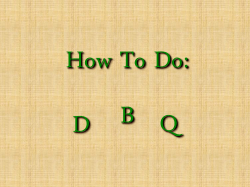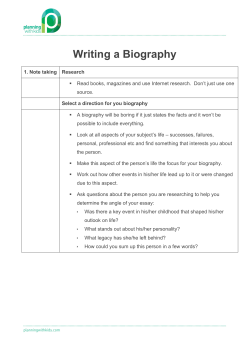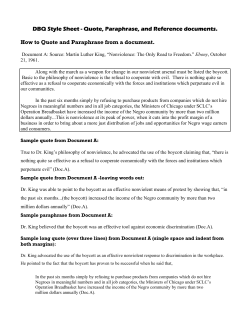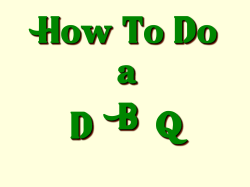
1302
1302 • Freewrite: Open your book to the Student Sample BA 2s in your First-Year Writing book (pp.583-585). 1. Identify the thesis of each sample. Which sample’s thesis is easier to identify; why? 2. Which sample do you think is best; why? QUESTIONS, COMMENTS, THOUGHTS? Y O U R B A 1 & PA 1 C O M M E N TA R Y SYNTHESIS IS THE FLIP SIDE OF ANALYSIS: • you already understand the parts, so your job is to assemble them into a new whole. Notes from the eHandbook TO SYNTHESIZE SOURCES FOR A RESEARCH PROJECT, TRY THE FOLLOWING TIPS: • Read the material carefully. • Determine the important ideas in each source. • Formulate a position. Review the key ideas of each source and figure out how they fit together. Look for patterns: discussions of causes and effects, specific parts of a larger issue, background information, and so on. Be sure to consider the complexity of the issue, and demonstrate that you have considered more than one perspective. • Summon evidence to support your position. You might use paraphrases, summaries, or direct quotations from your sources as evidence • Deal with counterarguments. You don’t have to use every idea or every source available—some will be more useful than others. However, ignoring evidence that opposes your position makes your argument weaker. You should acknowledge the existence of valid opinions that differ from yours, and try to explain why they are incorrect or incomplete. • Combine your source materials effectively. Be careful to avoid simply summarizing or listing your research. Think carefully about how the ideas in your reading support your argument. Try to weave the various sources together rather than discussing your sources one by one. SYNTHESIS MAPPING Blog Materials SYNTHESIS IS NATURAL Whenever you talk to a friend that things several other friends has said about the film or CD you engaged and synthesis. People synthesize information naturally to help others to see if the connections between things they learn; you have probably stored up a mental data bank of the various things you’ve heard about particular professor. If your data bank contains several negative comments, you might synthesize that information and use it to help you decide not to take a class with that particular professor. SYNTHESIS IS NATURAL Synthesis is related to, but not the same as classification, division, or comparison and contrast. Instead of attending to categories or finding similarities and differences, synthesizing sources is a matter of pulling them together into some kind of harmony. Synthesis searches for links between materials for the purposes of constructing a thesis or theory. KEY FEATURES OF SYNTHESIS 1. It accurately reports information from the sources using different phrases and sentences 2. It is organized in such a way that readers can immediately see where the information from the sources overlap 3. It makes sense of the sources and helps the reader understand them in greater depth DIFFERENCE BETWEEN A REPORT AND SYNTHESIS? Each topic sentence, instead of simply introducing the material for the paragraph that will follow, will link back to the thesis and assert that the information to be synthesize/presented below is essential because … SO WHAT? Your primary purpose is to show readers that you are familiar with the field and are thus qualified to offer your opinions. But your larger purpose is to show that in spite of all this wonderful research, no one has addressed the problem in the way that you intend to in your paper. SYNTHESIS ESSAY: INTRODUCTION • Contains a one-sentence (maybe two) statement that sums up the focus of your synthesis. • Also introduces the texts to be synthesized: • Givers the title and author of each source • Sometimes provides pertinent background information about the authors, about the texts to be summarized, or about the general topic from which the texts are drawn SYNTHESIS ESSAY: BODY This should be organized by them, point, similarity, or aspect of the topic. Your organization will be determined by the patterns you see in the materials you are synthesizing. Make sure your work represents the text fairly. Look upon yourself as a synthesizing machine. SYNTHESIS ESSAY: CONCLUSION When you have finished your paper, write a conclusion reminding readers of the most significant themes you have found and the ways they connect to the overall topic. Most importantly, you will want to suggest further research or comment on things that is was not possible for you to discuss in the paper. This may be the place you set up the exigency for a future argument. BA 2: TO COMPLETE THIS ASSIGNMENT, YOU WILL NEED TO WRITE A THESIS-DRIVEN SYNTHESIS OF THREE ARTICLES. You will want to identify a common theme or idea that you see running through all of the articles and focus on how each article develops or contributes to the theme. We have selected the following articles from your textbook for this assignment: 1. Sven Birkerts: "Into the Electronic Millennium" pp. 226-233 2. Stephen Budiansky: "Lost in Translation" pp. 238-244 3. T ina Rosenberg: "Everyone Speaks Text Message" pp. 267-271 BA 2: OUTLINE 1. Read each article through once so that you understand its scope and the author’s argument. 2. As you begin to read through each article again, note common themes and ideas. What are the things these authors agree and disagree about? (Hint: You may find it helpful to use an organizational tool such as a Venn diagram.) 3. Create a working thesis statement based on one common theme or idea that runs through all three articles (a statement that will tie all three articles together in some way). There will be several possible common themes or ideas for you to choose from. Pick the one that you can develop in the most detail. 4. Then, write an essay which summarizes and synthesizes these articles. In other words, describe the common theme, explain how each author develops the common theme, and then explain how each article relates to the others. What are their similarities and differences? Why are these similarities and differences important to the theme which you are examining? Length: 400 - 600 words Format: MLA style for internal citations and works cited. GROUP WORK: BASED ON WHAT WE HAVE DISCUSSED ABOUT SYNTHESIS, RESPOND TO THE FOLLOWING PROMPTS ABOUT THE STUDENT SAMPLE OF SYNTHESIS IN YOUR TEXTBOOK. • Does the student have the appropriate thesis statement for a synthesis paper? If yes, how so? If not, how might the thesis statement be revised? • What is effective about the introductory paragraph? • What is ineffective about the introductory paragraph? • Identify places of synthesis in the body paragraphs. How can you tell that the student is synthesizing? For example, are there certain transitional words that the writer uses to show synthesis? • Do the body paragraphs relate directly back to the thesis? If so, explain how. If not, what aspects of the thesis statement are not addressed in the body paragraphs? PA 2 Formal Outline – Information on Blog
© Copyright 2025





















